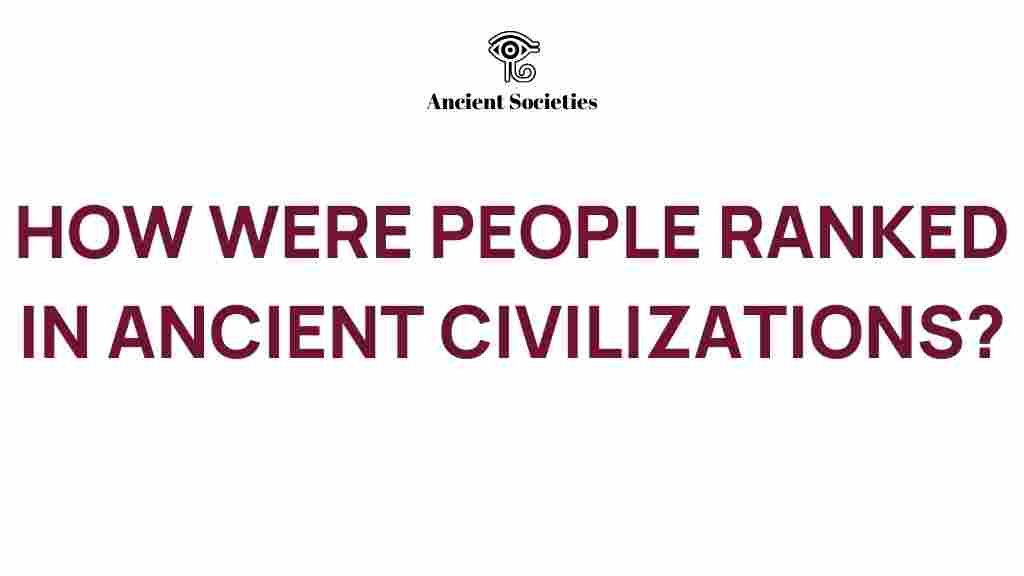Unraveling the Social Hierarchies of Ancient Civilizations
The study of ancient civilizations reveals a fascinating tapestry of human interaction, development, and societal organization. One of the most compelling aspects of these historical societies is their social hierarchy. Understanding the class structure, ranking systems, and cultural norms of these ancient peoples is essential for grasping how power dynamics shaped their lives and legacies. In this article, we will explore the various facets of social hierarchies in ancient civilizations, examining how they influenced societal roles and interactions.
Understanding Social Hierarchy in Ancient Civilizations
Social hierarchies in ancient civilizations were not just arbitrary classifications; they were deeply rooted in the cultural norms and beliefs of each society. The following points outline key components of these hierarchies:
- Class Structure: Ancient societies often divided their populations into distinct classes, including nobility, clergy, merchants, artisans, and laborers.
- Ranking Systems: These classes were typically ranked, with nobility and clergy holding the highest positions, followed by wealthy merchants and skilled artisans, down to laborers and slaves.
- Power Dynamics: The distribution of power within these hierarchies influenced governance, economics, and social stability.
- Societal Roles: Each class had specific roles and responsibilities, which were often dictated by tradition and necessity.
Key Ancient Civilizations and Their Social Hierarchies
To illustrate the complexity of social hierarchies, let’s examine a few notable ancient civilizations: Mesopotamia, Ancient Egypt, and the Indus Valley.
Mesopotamia
Mesopotamian society was characterized by a clear class structure:
- Nobility: Kings and their families held significant power, often claiming divine right.
- Priests: As intermediaries between the gods and the people, priests wielded considerable influence.
- Merchants and Artisans: These individuals contributed to the economy and cultural development.
- Farmers and Laborers: They formed the backbone of the economy, working the land and supporting the ruling class.
- Slaves: Often prisoners of war or indebted individuals, slaves had no rights and were considered property.
Ancient Egypt
In Ancient Egypt, the social hierarchy was similarly stratified:
- Pharaoh: The Pharaoh was considered a god-king, the ultimate authority.
- Nobles and Priests: They assisted the Pharaoh in governance and religious rituals.
- Merchants and Artisans: They engaged in trade and craft, generally enjoying a decent lifestyle.
- Farmers: While crucial for sustenance, they often had to give a portion of their produce to the nobility.
- Slaves: Similar to Mesopotamia, slaves were at the bottom of the social ladder.
Indus Valley Civilization
The Indus Valley Civilization presents an intriguing case, as much about its social structure remains a mystery due to the undeciphered script. However, archaeological evidence suggests a complex class structure:
- Urban Elite: Likely the ruling class, living in well-planned cities like Mohenjo-Daro.
- Craftspeople and Traders: Engaged in commerce and skilled crafts, indicating a thriving economy.
- Agricultural Workers: Provided the food necessary for urban centers.
The Role of Archaeology in Understanding Social Hierarchies
Archaeology plays a crucial role in unveiling the social hierarchies of ancient civilizations. Through excavations, artifacts, and settlement patterns, archaeologists can infer the societal roles and class structures of historical societies. For instance:
- Artifacts: Items like pottery, tools, and jewelry can indicate the wealth and status of individuals.
- Burial Practices: The manner in which individuals were buried often reflected their social status, with elaborate tombs indicating high rank.
- Settlement Patterns: The layout of cities and the size of homes can reveal information about the power dynamics within a society.
For more detailed insights into archaeological methods, visit this resource.
Step-by-Step Process of Analyzing Social Hierarchies
To analyze the social hierarchy of a specific ancient civilization, researchers typically follow these steps:
- Identify the Civilization: Select an ancient civilization for study, such as the Roman Empire or Ancient China.
- Gather Historical Data: Review historical texts, inscriptions, and previous archaeological findings.
- Conduct Excavations: Engage in archaeological digs to uncover artifacts and structures.
- Analyze Artifacts: Examine the discovered items to understand their cultural significance and implications for social status.
- Interpret Findings: Synthesize the data to draw conclusions about the class structure and societal roles.
Troubleshooting Common Challenges
Researchers studying ancient civilizations often encounter challenges, including:
- Inaccessibility of Sites: Some archaeological sites may be difficult to access due to political instability or environmental factors.
- Incomplete Records: Many ancient texts are damaged or lost, making it hard to gain a full understanding of societal norms.
- Interpretation Bias: Modern biases can affect interpretations of ancient practices and beliefs; it is crucial to remain objective.
To overcome these challenges, researchers can collaborate with local experts, utilize modern technology for site analysis, and remain open to revising hypotheses based on new evidence.
The Impact of Social Hierarchies on Modern Society
Understanding the social hierarchies of ancient civilizations provides valuable insights into our own societal structures. The legacies of these hierarchies can be seen in contemporary issues such as:
- Economic Inequality: The foundations of wealth distribution trace back to ancient class structures.
- Political Power: Modern political systems often reflect historical power dynamics.
- Cultural Norms: Many societal expectations and roles have roots in ancient practices.
Conclusion
The exploration of social hierarchies in ancient civilizations enriches our understanding of human history and the evolution of societies. By examining the class structure, ranking systems, and the power dynamics at play, we gain insights not only into the past but also into the present. As we continue to uncover the layers of history through archaeology, the stories of these historical societies will inform our understanding of societal roles and cultural norms today.
To delve deeper into the complexities of ancient social structures, consider exploring more resources on historical societies and their legacies.
This article is in the category History and created by AncientSocieties Team
